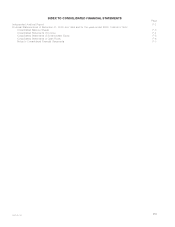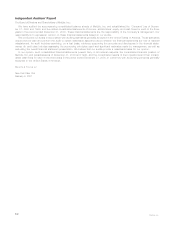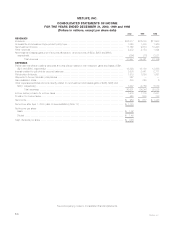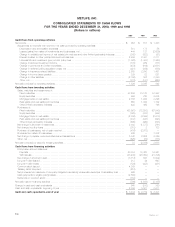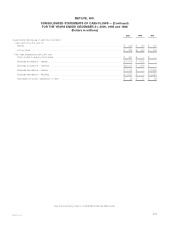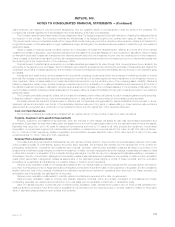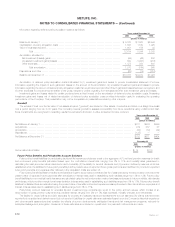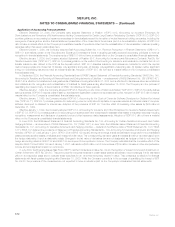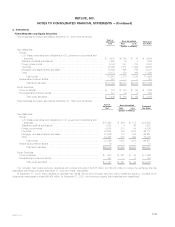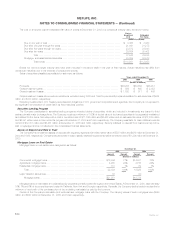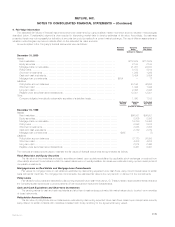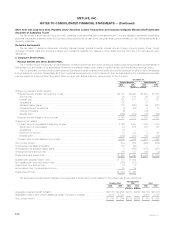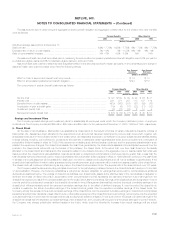MetLife 2000 Annual Report Download - page 42
Download and view the complete annual report
Please find page 42 of the 2000 MetLife annual report below. You can navigate through the pages in the report by either clicking on the pages listed below, or by using the keyword search tool below to find specific information within the annual report.METLIFE, INC.
NOTES TO CONSOLIDATED FINANCIAL STATEMENTS — (Continued)
Recognition of Insurance Revenue and Related Benefits
Premiums related to traditional life and annuity policies with life contingencies are recognized as revenues when due. Benefits and expenses are
provided against such revenues to recognize profits over the estimated lives of the policies. When premiums are due over a significantly shorter period
than the period over which benefits are provided, any excess profit is deferred and recognized into operations in a constant relationship to insurance in-
force or, for annuities, the amount of expected future policy benefit payments.
Premiums related to non-medical health contracts are recognized on a pro rata basis over the applicable contract term.
Deposits related to universal life and investment-type products are credited to policyholder account balances. Revenues from such contracts
consist of amounts assessed against policyholder account balances for mortality, policy administration and surrender charges. Amounts that are charged
to operations include interest credited and benefit claims incurred in excess of related policyholder account balances.
Premiums related to property and casualty contracts are recognized as revenue on a pro rata basis over the applicable contract term. Unearned
premiums are included in other liabilities.
Policyholder Dividends
Policyholder dividends are approved annually by the boards of directors. The aggregate amount of policyholder dividends is related to actual interest,
mortality, morbidity and expense experience for the year, as well as management’s judgment as to the appropriate level of statutory surplus to be retained
by the insurance subsidiaries.
Participating Business
Participating business represented approximately 22% and 19% of the Company’s life insurance in-force, and 81% and 83% of the number of life
insurance policies in-force, at December 31, 2000 and 1999, respectively. Participating policies represented approximately 47% and 50%, 50% and
54%, and 45% and 47% of gross and net life insurance premiums for the years ended December 31, 2000, 1999 and 1998, respectively. The
percentages indicated are calculated excluding the business of the Reinsurance segment.
Income Taxes
The Holding Company and its includable life insurance and non-life insurance subsidiaries file a consolidated U.S. federal income tax return in
accordance with the provisions of the Internal Revenue Code of 1986, as amended (the ‘‘Code’’). Non-includable subsidiaries file either separate tax
returns or separate consolidated tax returns. Under the Code, the amount of federal income tax expense incurred by mutual life insurance companies
includes an equity tax calculated based upon a prescribed formula that incorporates a differential earnings rate between stock and mutual life insurance
companies. Metropolitan Life is not subject to the equity tax after the date of demutualization. The future tax consequences of temporary differences
between financial reporting and tax bases of assets and liabilities are measured at the balance sheet dates and are recorded as deferred income tax
assets and liabilities.
Reinsurance
The Company has reinsured certain of its life insurance and property and casualty insurance contracts with other insurance companies under
various agreements. Amounts due from reinsurers are estimated based upon assumptions consistent with those used in establishing the liabilities related
to the underlying reinsured contracts. Policy and contract liabilities are reported gross of reinsurance credits. Deferred policy acquisition costs are
reduced by amounts recovered under reinsurance contracts. Amounts received from reinsurers for policy administration are reported in other revenues.
The Company assumes and retrocedes financial reinsurance contracts, which represent low mortality risk reinsurance treaties. These contracts are
reported as deposits and are included in other assets. The amount of revenue reported on these contracts represents fees and the cost of insurance
under the terms of the reinsurance agreement.
Separate Accounts
Separate accounts are established in conformity with insurance laws and are generally not chargeable with liabilities that arise from any other
business of the Company. Separate account assets are subject to general account claims only to the extent the value of such assets exceeds the
separate account liabilities. Investments (stated at estimated fair value) and liabilities of the separate accounts are reported separately as assets and
liabilities. Deposits to separate accounts, investment income and recognized and unrealized gains and losses on the investments of the separate
accounts accrue directly to contractholders and, accordingly, are not reflected in the Company’s consolidated statements of income and cash flows.
Mortality, policy administration and surrender charges to all separate accounts are included in revenues.
Foreign Currency Translation
Balance sheet accounts of foreign operations are translated at the exchange rates in effect at each year-end and income and expense accounts are
translated at the average rates of exchange prevailing during the year. The local currencies of foreign operations are the functional currencies unless the
local economy is highly inflationary. Translation adjustments are charged or credited directly to other comprehensive income or loss. Gains and losses
from foreign currency transactions are reported in earnings.
Earnings Per Share
Earnings per share amounts, on a basic and diluted basis, have been calculated based upon the weighted average common shares outstanding or
deemed to be outstanding only for the period after the date of demutualization.
Basic earnings per share is computed based on the weighted average number of shares outstanding during the period. Diluted earnings per share
includes the dilutive effect of forward purchase contracts, using the treasury stock method. Under the treasury stock method, exercise of the forward
purchase contracts is assumed with the proceeds used to purchase common stock at the average market price for the period. The difference between
the number of shares assumed issued and number of shares assumed purchased represents the dilutive shares.
MetLife, Inc. F-11


